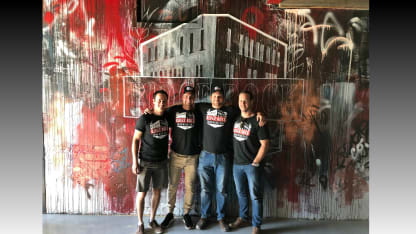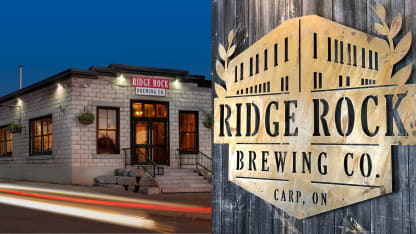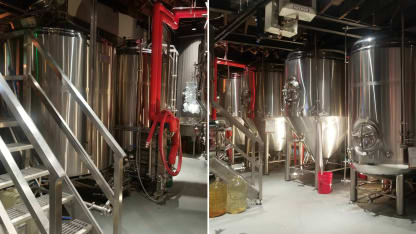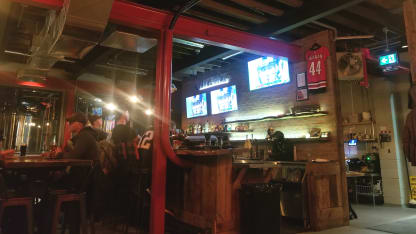De Haan helps revitalize hometown with new craft brewery
Hurricanes defenseman teamed with friends to invest in, transform historic building

This four-hour daily undertaking followed by a couple more hours of repairs and errands might not have been what he envisioned for semi-retirement after almost 40 years in construction and landscaping, but the 56-year-old is loving every minute of supporting his son, Carolina Hurricanes defenseman Calvin de Haan, who co-owns the place with three friends from their neighborhood near Ottawa.
In less than two years with enthusiastic help from the community, they've turned the formerly ramshackle building into their hometown's newest attraction.
"I'm there by myself and when I go in there every morning, I like going into the building and turning on the (music) and looking around and saying, 'This building is cool, I like it here,' and I do," Bill de Haan said. "My wife and I try to go there once a week. Even though I've spent five or six or seven hours there already, I'll go there and be a customer and it's great."
The building, which everyone in Carp has passed countless times since it was built in the 1860s, is a standalone cinder block structure that you can't miss on the most prominent corner of a village of 2,000 people. Over the years it's taken many forms including a car dealership, a bank, a bus repair station, a gas station and a pharmacy. For Calvin de Haan, 27, and co-owners, Jake Sinclair, Jason Lalonde and Ryan Grassie, they grew up with it as a furniture and cabinet business whose owner kept dirt bikes and go-karts in the basement.

Sinclair and Lalonde had their eye on the historical building for a while, knowing there was massive potential in the cavernous space, but the owner was never interested in selling. When he had a sudden change of heart two years ago, the pair jumped on it so quickly the listing never made it to the open market.
Around that time, Sinclair and Lalonde had been discussing opening a brewery with Grassie and de Haan, and the plans started falling into place.
They wanted to give people in their hometown a spot to hang out and enjoy a beer, which hadn't really existed in their lifetimes. For the adults in town, a night out meant traveling around 10 miles to Kanata, where the Ottawa Senators play their home games, or 25 miles to downtown Ottawa.
As commercial and residential development made its way closer to Carp, the four friends saw an opportunity to make a new destination in their village, which was mostly known for the annual Carp Fair in the summer and the Diefenbunker, Canada's Cold War Museum.
When they took ownership of the building, its condition was nowhere near the intimate, rustic hangout it is now.
"The transformation was wild," Calvin de Haan said. "There was literally nothing. It was four walls and a roof."
The renovation was a long list of big ticket items, including tanks for brewing the beer, a commercial kitchen, walls, additional roof structure, patching adult human-sized holes in the cement floor, and putting in all new plumbing and an HVAC system.
The budget for the project probably never stood a chance, but it was important for them to use Canadian-made equipment and local contractors, and pull as much of the history of the building into the design as possible.

There are winks and nods to old tales they unearthed after they took ownership. The building was involved in one of Canada's most notorious bank robberies, when 72 safe deposit boxes were stolen in 1947 through an underground tunnel that began underfoot. They installed a bank vault door in the basement that opens to a conference room with a smart TV and beer tap that's available for businesses to rent.
"There are all these crazy stories," Grassie said. "And just when we think we've heard them all, a couple of local older people come in and have lunch and tell us stories that we'd never heard. "
The foot railing at the bar is from a Carp train track from the late 1800s. The picture just inside the front door is of the building in its original state, a two-story building that was gutted in a fire and rebuilt as one spacious floor. The two-story facade is the inspiration for the brewery's logo.
Among the finishing touches are red steel beams to match de Haan's Hurricanes jersey, which hangs above the bar, a large graffiti-style mural in Carolina red, white and black in the main dining area by local artist Candice Wei, various old photos of Carp in its formative days, and a nook with a big square wooden table, bench seating and board games.
The deep brown leather armchairs and couches by the entrance were de Haan's idea for an area where customers could relax away from the crowd. So too was Wei's mural, a signature part of some of de Haan's favorite establishments from his time with the New York Islanders.
"We're trying something different, trying to get people to stick around," he said. "If it's playing some random board games or whatever, it's to get people in and we want them to stay."

By the time they were ready to open in September, about 14 months after they started, just about every employee, no matter what their official title, had picked up a paint brush or hammer or some other tool to help bring the place to life.
"We had full-time crews every weekend and through the week," Grassie said. "We didn't have slow contractors or anything. Everyone was hustling during that time. It was just so much to do."
To say the locals were impressed would be an understatement.
In their first month in business, they ran out of beer twice. They've since upped their production and added two large capacity beer fridges.
Brewmaster Jamie Maxwell had come up with a signature line of approachable beers that he and the owners wanted to help introduce their community of blue-collar workers, with beer tastes to match, to the world of craft beers.
De Haan himself hadn't ventured much into craft beer until this project started, but has since grown to love it, especially in North Carolina where there are more than 300 craft breweries, many of which are in the Hurricanes' Raleigh home.
"I appreciate the time and effort that people put into it," he said. "Now that I know the process, it's wild. Our brewmaster takes mega-pride in his beer. It's his creation and he's very proud of it. He's one of the best in Ottawa for that reason."
The live music and open-mic nights have further involved the community, and Maxwell's special seasonal brews have become an attraction as well.
But the real testament to the brewery are its patrons, many of whom were already invested in it before it even opened.
"We wanted everyone to, when it was done, feel like they had a part in it and they would come there and be able to enjoy it," Grassie said. "There are a lot of contractors that helped build that place that I see in there every weekend with their families or their kids or their friends, so it's really cool and they're proud of the place that they helped build."
The de Haan family moved to Carp more than two decades ago, and many of their neighbors have been there for generations watching the village go from the bustling center of Ottawa to a rural community on the outskirts, always with this big cinder-block building with ever-changing purposes.
"We moved here when Calvin was a year old, so almost 27 years now and the building was always kind of an eyesore, like what's anybody gonna do with this?" said Bill de Haan, whose new job at the brewery has helped him slim down by 20 pounds and resulted in well-rested nights for a change. "What he and his partners have done is great. We needed a place to come to and it's right on the main corner of the village. The building looks so much better. Hopefully it'll be a go-to place."

















